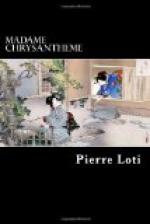As a matter of course, we are on visiting terms with all these ladies.
First there is our very merry neighbor Madame Campanule, who is little Charles N——’s wife; then Madame Jonquille, who is even merrier than Campanule, like a young bird and the daintiest fairy of the whole lot: she has married X——, a fair northerner who adores her; they are a loverlike and inseparable pair, the only one that will probably weep when the hour of parting comes. Then Sikou-San with Doctor Y——; and lastly the midshipman Z—— with the tiny Madame Touki-San, no taller than a boot: thirteen years old at the outside and already a regular woman, full of her own importance, a petulant little gossip. In my childhood, I was sometimes taken to the Learned Animals Theater, and I remember a certain Madame de Pompadour, a principal role, filled by a gayly dressed-up old monkey; Touki-San reminds me of her.
In the evening, all these folk generally come and fetch us for a long processional walk with lighted lanterns. My wife, more serious, more melancholy, perhaps even more refined, and belonging, I fancy, to a higher class, tries when these friends come to us to play the part of the lady of the house. It is comical to see the entry of these ill-matched couples, partners for a day, the ladies with their disjointed bows falling on all fours before Chrysantheme, the queen of the establishment. When we are all assembled, we start off, arm in arm, one behind the other, and always carrying at the end of our short sticks little white or red paper lanterns;—it seems it is pretty.
We are obliged to scramble down the kind of street, or rather goat’s-path, which leads to the Japanese Nagasaki,—with the prospect, alas! of having to climb up again at night; clamber up all the steps, all the slippery slopes, stumble over all the stones, before we shall be able to get home, go to bed, and sleep. We make our descent in the darkness, under the branches, under the foliage, betwixt dark gardens and venerable little houses that throw but a faint glimmer on the road; and when the moon is absent or clouded over, our lanterns are by no means unnecessary.
When at last we reach the bottom, suddenly, without transition, we find ourselves in the very heart of Nagasaki and its busy throng in a long illuminated street, where vociferating djins hurry along and thousands of paper lanterns swing and gleam in the wind. It is life and animation, after the peace of our silent suburb.
Here, decorum requires we should separate from our wives. All five take hold of each others’ hands, like a batch of little girls out walking. We follow them with an air of indifference. Seen from behind, our dolls are really very dainty, with their back hair so tidily done up, their tortoiseshell pins so coquettishly arranged. They shuffle along, their high wooden clogs making an ugly sound, striving to walk with their toes turned in, according to the height of fashion and elegance. At every minute they burst out laughing.




